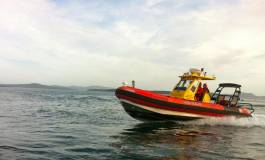





SARnav 2
The SARnav 2 course is designed to allow a complete crew to effectively navigate using all available means to achieve positive control while underway and during collision avoidance situations. The material is aimed at members of the Canadian Coast Guard Auxiliary - Pacific (CCGA-P) that have completed the SAR Advanced Crew Standard and RHIOT and are working on the Coxswain Standard.Active coxswains from stations with enclosed-cabin vessels are being given priority for enrollment in the SARnav course, but is open to active coxswains from other stations.
Prerequisites
SARnav 2 is a challenging course that follows an aggressive schedule which covers a lot of material in a very short time. To ensure a base level of skills and knowledge prior to enrolling in the course, participants must have completed the following prerequisites:- CCGA-P Crew Standard At a minimum completion of the crew level standard is required (and must be correctly documented); however is expected that most participants will be well into their Advanced Crew level prior to enrolling in the course.
- Current Sea Time participants must have current sea time that meets or exceeds the established crewing standards for the CCGA-P
- Experience Participants should have recent practical experience on-the-water and working with Raymarine radar. They should have familiarity with making easy comparisons between what they see on the radar and what is shown on the chart.
- RHIOT The SARnav course includes on-water components that assume participants have successfully completed the CCG RHIOT course.
- SLS Workbook 1 A basic knowledge of electronic navigation equipment as presented in the SAR Learning System - workbook 1 is essential. This includes passing the SLS Workbook 1 final exam.
SARnav Pre-Study Materials
It is essential that all participants review the pre-study materials (sent by mail) and complete a few practice quizzes prior to their course. They should also spend as much time as possible working with their radar equipment on the water. An on-water exercise has been developed to help participants prepare and gain additional radar experience:The Raymarine E-Series multifunction display (the recommended CCGA-P fleet standard unit) is used throughout the SARnav 2 course. There will be a brief session to familiarize participants with this equipment on the first day of the course. It is important that you review the buttonology of the e80 unit prior to the course. You will find video tutorials throughout the SLS - Workbook 1 that will help you to understand the e80. The e80 Handbook is also a great reference:
What to Expect
“ The professional and supportive instruction provided at the course will go a long way in reducing the present variability in station training programs”
It will probably help to have some idea of what to expect when you arrive for the course. There will be 6 participants in the course and 2 instructors, the course is four days over a weekend. One of the first components of the course is an exam that covers material from the pre-study package, SLS - workbook 1, and Crew Standard. Just like RHIOT, you must pass this exam to continue with the SARnav course.
The remainder of the course includes a combination of classroom sessions, time in the simulator, desktop simulations, desktop e80 practice, and on-water sessions including a night run. For the simulator and on-water sessions the participants will be grouped into two crews of three and there will be alternating sessions between the two groups. You will not be grouped with anyone from your station so it is important to work together as a team and overcome differences in station standard operating procedures.
There is a final written exam and practical evaluation on the last day of the course.
What to Bring
Bring Your CCGA-P Log Book so the instructor can sign-off the relevant sections completed during the course.Gear
It is essential that you bring all your normal boat gear for day and night operation on-water. We may be going out in inclement weather and it may be cold and very wet. During summer courses the daytime sessions may be warm. Please come prepared. Here is a rough checklist:- Cruiser Suit or Dry Suit + PFD
- Warm, Appropriate Clothes/Undergarments
- Helmet
- Eye Protection
- Appropriate Footwear
- Gloves
- Loaded Equipment Vest with Required PPE
All standard classroom materials and navigation instruments will be provided.
